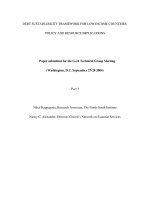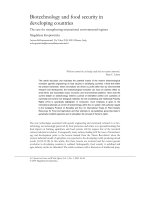WCDMA UTRAN Interface and Signaling Procedure ISSUE 1.1
Bạn đang xem bản rút gọn của tài liệu. Xem và tải ngay bản đầy đủ của tài liệu tại đây (878.4 KB, 84 trang )
WCDMA UTRAN
Interface and
Signaling
Procedure
www.huawei.com
Copyright © 2008 Huawei Technologies Co., Ltd. All rights reserved.
Objectives
Upon completion of this course, you will be able to:
Understand UTRAN interface and structure
Understand the definitions about UTRAN network
elements
Understand UTRAN signaling procedure
Copyright © 2008 Huawei Technologies Co., Ltd. All rights reserved.
Page2
Contents
1.
UTRAN Network Overview
2.
Basic Concepts about UTRAN
3.
UTRAN Signaling Procedure
Copyright © 2008 Huawei Technologies Co., Ltd. All rights reserved.
Page3
Contents
1.
UTRAN Network Overview
2.
Basic Concepts about UTRAN
3.
UTRAN Signaling Procedure
Copyright © 2008 Huawei Technologies Co., Ltd. All rights reserved.
Page4
The Position of UTRAN in
WCDMA Network
Copyright © 2008 Huawei Technologies Co., Ltd. All rights reserved.
Page5
UMTS Construction
CN
Iu
UTRAN
Uu
UE
UTRAN
CN
UE
UMTS Terrestrial Radio Access Network
Core Network
User Equipment
Copyright © 2008 Huawei Technologies Co., Ltd. All rights reserved.
Page6
UMTS Structure
Core Network
Iu
Iu
RNS
RNS
Iur
RNC
RNC
Iub
Iub
Iub
Iub
Node B
Node B
Node B
Copyright © 2008 Huawei Technologies Co., Ltd. All rights reserved.
Page7
Node B
Uu Interface
GC
Nt
DC
Duplication avoidance
GC
Nt
DC
UuS boundary
C-plane signalling
U-plane information
control
L3
control
control
control
control
RRC
Radio
Bearers
PDCP
PDCP
L2/PDCP
BMC
RLC
RLC
RLC
RLC
RLC
RLC
RLC
L2/BMC
L2/RLC
RLC
Logical
Channels
MAC
L2/MAC
Transport
Channels
PHY
L1
General Protocol Mode for UTRAN
Terrestrial Interface
The structure is based on the principle that the layers
and planes are logically independent of each other.
Radio
Network
Layer
Control Plane
User Plane
Application
Protocol
Data
Stream(s)
Transport
Network
Layer
Transport Network
User Plane
Transport Network
Control Plane
Transport Network
User Plane
ALCAP(s)
Signalling
Bearer(s)
Signalling
Bearer(s)
Physical Layer
Data
Bearer(s)
RNL Control Plane Application
Protocol
CN
RANAP
UE
RRC
RNC
RNSAP
RNC
NBAP
Node B
NBAP : Node B Application Part
RANAP : Radio Access Network Application Part
RNSAP : Radio Network Subsystem Application Part
RRC : Radio Resource Control
Copyright © 2008 Huawei Technologies Co., Ltd. All rights reserved.
Page13
Iu-CS Interface
Radio
Network
Layer
Control Plane
User Plane
Iu UP Protocol
Layer
RANAP
Transport
Network
Layer
Transport Network
User Plane
Transport Network
Control Plane
Transport Network
User Plane
Q.2630.1
SCCP
MTP3b
Q.2150.1
MTP3b
SSCF-NNI
SSCF-NNI
SSCOP
SSCOP
AAL5
AAL5
AAL2
ATM
Physical Layer
Copyright © 2008 Huawei Technologies Co., Ltd. All rights reserved.
Page14
Iu-PS Interface
Radio
Network
Layer
Control Plane
User Plane
Iu UP Protocol
Layer
RANAP
Transport
Network
Layer
Transport Network
User Plane
Transport Network
Control Plane
Transport Network
User Plane
SCCP
M3UA
MTP3-B
SCTP
GTP-U
SSCF-NNI
SSCF-NNI
UDP
IP
SSCOP
IP
AAL5
AAL5
ATM
ATM
Physical Layer
Copyright © 2008 Huawei Technologies Co., Ltd. All rights reserved.
Physical Layer
Page15
Iub Interface
Radio Network
Control Plane
User Plane
Q.2630.1
Q.2150.2
Transport
Layer
SSCF-UNI
SSCF-UNI
SSCOP
SSCOP
AAL Type 5
AAL Type 5
AAL Type 2
ATM
Physical Layer
Copyright © 2008 Huawei Technologies Co., Ltd. All rights reserved.
Page16
CPCH FP
ALCAP
USCH FP
DSCH FP
PCH FP
FACH FP
Node B
Application Part
(NBAP)
RACH FP
DCH FP
Radio
Network
Layer
Transport
Network
Control Plane
Iur Interface
Radio
Network
Layer
Control Plane
User Plane
Iur Data
Stream(s)
RNSAP
Transport
Network
Layer
Transport Network
User Plane
Transport Network
Control Plane
Transport Network
User Plane
ALCAP(Q.2630.1)
SCCP
MTP3-B
M3UA
SSCF-NNI
SCTP
SSCOP
IP
AAL5
STC (Q.2150.1)
MTP3-B
M3UA
SSCF-NNI
SCTP
SSCOP
IP
AAL5
AAL2
ATM
Physical Layer
Copyright © 2008 Huawei Technologies Co., Ltd. All rights reserved.
Page17
Contents
1.
UTRAN Network Overview
2.
Basic Concepts about UTRAN
3.
UTRAN Signaling Procedure
Copyright © 2008 Huawei Technologies Co., Ltd. All rights reserved.
Page18
SRNC/DRNC
CN
Iu
SRNC
Iur
DRNC
SRNC and DRNC are on a per connection basis between a UE and
the UTRAN
The SRNC handles the connection to one UE, and may borrow
radio resources of a certain cell from the DRNC
Drift RNCs support the Serving RNC by providing radio resources
A UE in connection state has at least one and only one SRNC, but
can has 0 or multiple DRNCs
Copyright © 2008 Huawei Technologies Co., Ltd. All rights reserved.
Page19
CRNC
CN
...
Iu
Iub
CRNC
Node B
Node B
Cell
Cell
Cell
The CRNC owns the radio resources of a cell
Dynamical control of power for dedicated channels, within limits
admitted by CRNC, is done by the SRNC.
Scheduling of data for dedicated channels is done by the SRNC,
while for common channels it is done by the CRNC
Copyright © 2008 Huawei Technologies Co., Ltd. All rights reserved.
Page20
RAB, RB and RL
RAB
RB
UE
RL
RNC
CN
NodeB
UTRAN
Copyright © 2008 Huawei Technologies Co., Ltd. All rights reserved.
Page21
UE Working Modes and States
Idle mode
Connected mode
Cell_DCH
Cell_FACH
Cell_PCH
URA_PCH
Copyright © 2008 Huawei Technologies Co., Ltd. All rights reserved.
Page22
Idle Mode
The UE has no relation to UTRAN, only to CN. For data transfer, a
signalling connection has to be established.
UE camps on a cell
It enables the UE to receive system information from the PLMN
When registered and if the UE wishes to establish an RRC connection,
it can do this by initially accessing the network on the control channel
of the cell on which it is camped
UE can receive "paging" message from control channels of the cell.
It enables the UE to receive cell broadcast services.
The idle mode tasks can be subdivided into three processes:
PLMN selection and reselection;
Cell selection and reselection;
Location registration.
Copyright © 2008 Huawei Technologies Co., Ltd. All rights reserved.
Page23
Connected Mode
When at least one signalling connection exists, the UE is
in connected mode and there is normally an RRC
connection between UE and UTRAN. The UE position can
be known on different levels:
UTRAN Registration Area (URA) level
The UE position is known on URA level. The URA is a set of
cells
Cell level
The UE position is known on cell level. Different transport
channel types can be used for data transfer:
Common transport channels (RACH / FACH, DSCH, CPCH)
Dedicated transport channels (DCH)
Copyright © 2008 Huawei Technologies Co., Ltd. All rights reserved.
Page24
Connected Mode
Cell-DCH
In active state
Communicating via its dedicated channels
UTRAN knows which cell UE is in.
Copyright © 2008 Huawei Technologies Co., Ltd. All rights reserved.
Page26
Connected Mode
Cell-FACH
In active state
Few data to be transmitted both in uplink and in
downlink. There is no need to allocate dedicated channel
for this UE.
Downlink uses FACH and uplink uses RACH.
UE need to monitor the FACH for its relative information.
UTRAN knows which cell UE is in.
Copyright © 2008 Huawei Technologies Co., Ltd. All rights reserved.
Page27
Connected Mode
Cell-PCH
No data to be transmitted or received.
Monitor PICH, to receive its paging.
lower the power consumption of UE.
UTRAN knows which cell UE is in.
UTRAN have to update cell information of UE when UE
roams to another cell
Copyright © 2008 Huawei Technologies Co., Ltd. All rights reserved.
Page28
Connected Mode
URA-PCH
No data to be transmitted or received.
Monitor PICH.
UTRAN only knows which URA (UTRAN Registration Area,
which consists of multiple cells) that UE is in.
UTRAN updates UE information only after UE has roamed
to other URA.
A better way to reduce the resource occupancy and
signaling transmission
Copyright © 2008 Huawei Technologies Co., Ltd. All rights reserved.
Page29









